Edward Passmore - A Saskatchewan Pioneer By Robert Passmore
This Biography includes a history of the Wood River area and events that led to the settlement of Lafleche, Saskatchewan.
Biography of Edward Passmore by his Grandson Robert Passmore
I am very grateful to the following people, books and records that were most helpful in preparing this biography:
Acknowledgments:
- - The 1928 booklet “Pioneer Days in Wood River".
- - North-West Mounted Police - A Tradition in Scarlet by Samuel Benfield Steele - Chapter 3 The March West.
- - The Journal of Charles and Laura (Passmore) Young by Janet Arens. Janet also edited this Biography and provided some suggestions for improvements.
- - The Anglican Church Archives at University of Western Ontario, London, Ont.
- - The Moose Jaw Library- Private Book Collection
- - Debra Belsey's records about the formation of the Sunbeam School District and the Registration & Pre-emption of Homestead Documents she obtained from Regina..
Image - Edward Passmore 1933
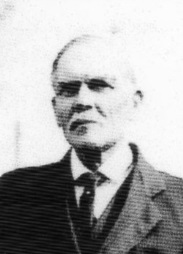
Edward Passmore was born October 16 1861 to John and Sarah Ann Passmore in his parents’ house on lot 11 Con. 11, Kinlough, Kinloss Township, Bruce County, Ontario, Canada. It was then known as Upper Canada. He attended a school that was built on land donated by his father in law John Pinnell. This school was a few hundred yards west of Edward's home. His father donated lumber to help build the school. He cut down trees on his property and had these cut into lumber at the mill owned by Simon Corrigan that was located on the N. W. corner of John Passmore's lot.
On the 1881 census Edward age 20 is listed as a hired man at the farm of Henry & Mary Thompson in Kinlough Lot 21 Con.10.
Edward had apprenticed as a stonemason along with his brother George. This was a good trade, because most of the barns in the area utilize local stones, as a foundation.
He married Katherine Hayes on March 28 1883. She lived up the road from his father John's farm. They were married at the bride's home on lot 2, # 2 Range S.D.R. in Kinloss by the Minister from St. Johns Anglican Church at Bervie. The wedding data transcribed by the Bruce County Genealogical society show the date of their marriage as Mar 28, 1883 and the index to Ontario marriages M. S. 934 reel 6 item 001741 confirms the date as 1883. This conflicts with his stated age, 21, on the entry of the marriage since he was born in 1861.
Image - Wedding of Catherine Matilda Hayes to Edward Passmore
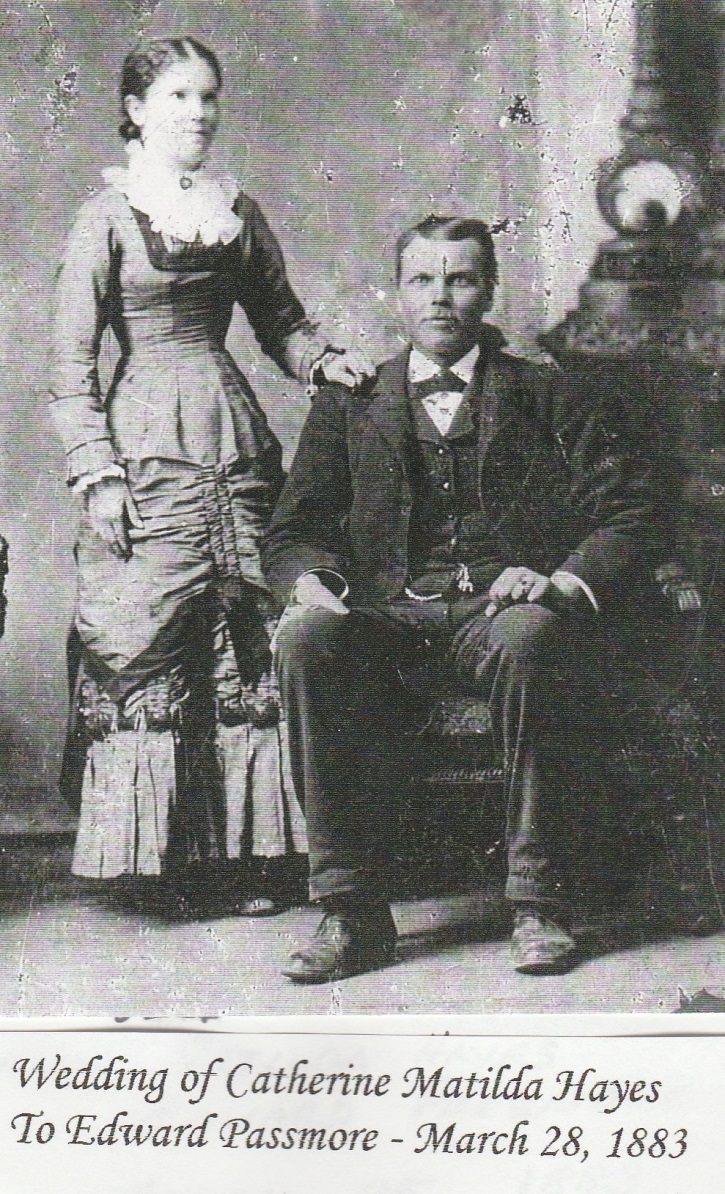
In 1890 Edward was ceded Lot 11 Con.12, lots 74, 75, 96, & 97 in Kinlough.
The Anglican Church of Ascension was located directly south from John Passmore's property just across the road. This is where Edward's father John Passmore took his own life in 1882. The Orange Hall was relocated to the site of the old Methodist Church directly west of John Passmore's farm and still stands. There are several graves behind the Orange Hall in the old Methodist Churchyard where several Pinnells are buried, including my Great Grandfather John Pinnell.
Image - The Passmore family circa 1898
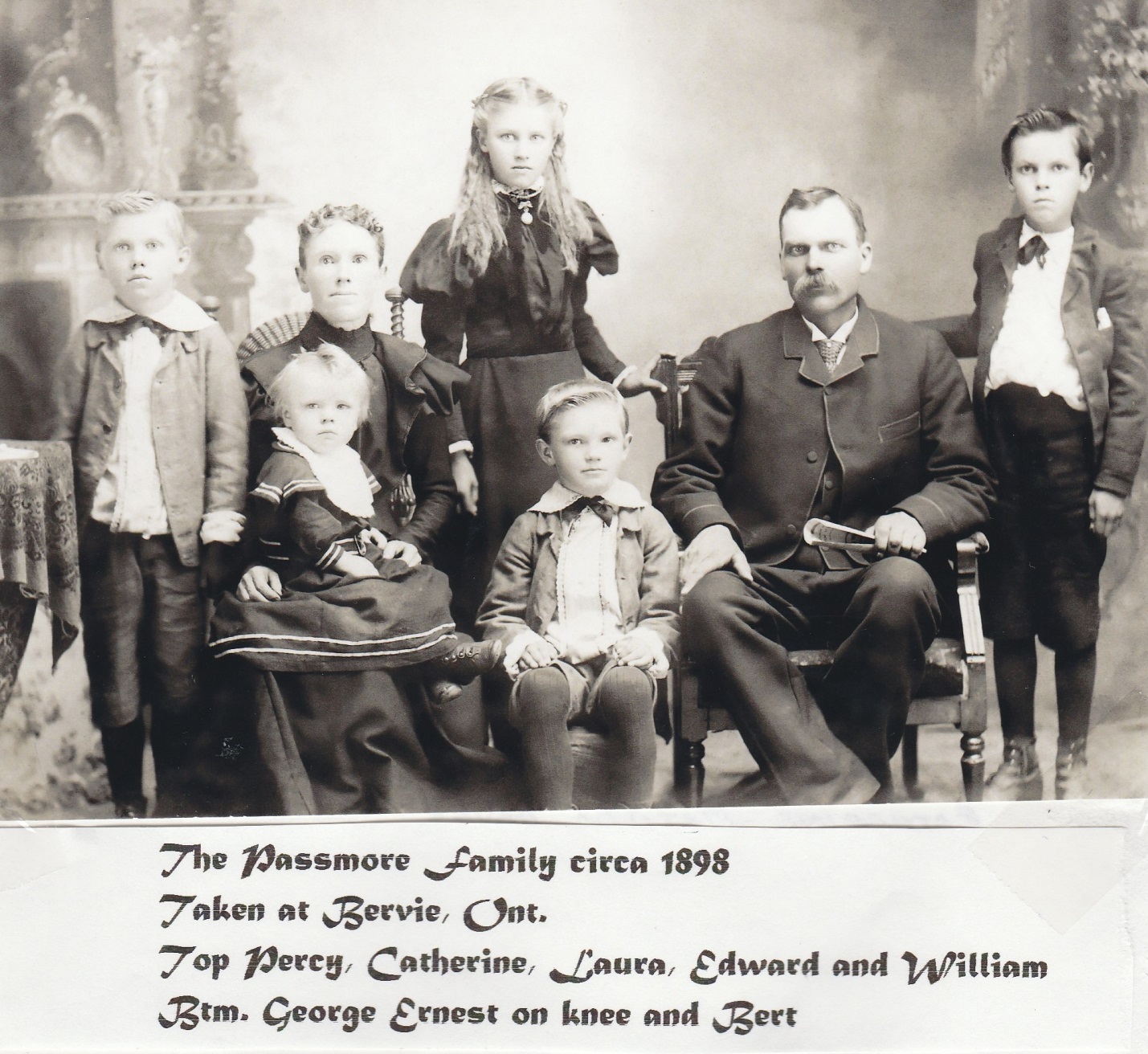
Most of the children of Edward and Catherine were born at Kinlough and they also attended the same schoolhouse which was built on land donated by Edward's Father-in-law, John Pinnell, in 1875. It is likely that Edward also attended this same school as he was only 13 when it was built.
On the 1891 census for Kinloss we find Edward 30, Catherine 29, with Laura 6, John 4, Percy 2 and Herbert 10/12. Edward is shown as a stonemason.
Sometime after 1891 and before 1895, Edward and Katherine, along with their entire family, moved about 10 Km. north to the Glammis area and farmed on 100 acres of leased land Lot 15, Con. 9, Bruce Township, Bruce County. On the 1901 census for Glammis, Edward is 39, Katherine is 38, Laura is 16, William 13(?), Percy 11, Nathaniel 9, George E. 5 (this is Dad) and Albert 1(this is Edwin Albert) are next door to William and Mary Young and their adopted son Charles 17 (future husband of Laura). This 1901 census for Glammis, Sect 10, Page 8, line 10-17 shows that Edward owned their house on 1/2 of an acre on this land that included 2 houses and a warehouse. The leased land included 2 barns. This is where my dad Ernie and his younger brother Edwin were born
Image - This picture of the land and house where the Passmore Family lived near Glammis, Ontario in 1901 was taken during my visit in 2000.
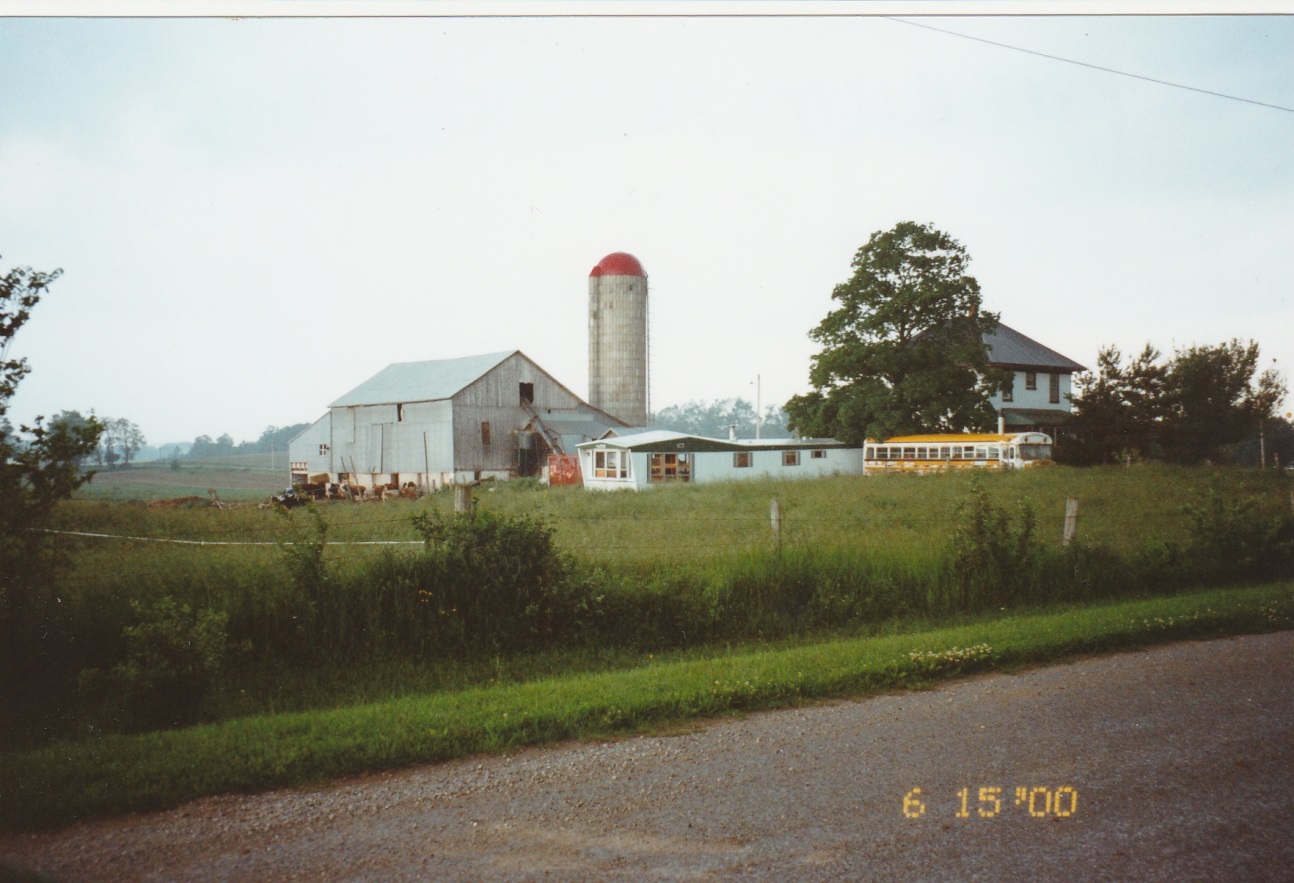
About 1907, Edward and his brother George decided to look into the potential westward migration to Saskatchewan. In the spring of 1907 they sent Edward's two oldest sons by train to Moose Jaw to scout for potential homesteading sites.
Before going into the western migration of the Passmores to the Wood River area of Saskatchewan, I believe that it is important to mention the events that happened in neighbouring Provinces that affected the history of the Wood River area prior to the settlement of the area that started in 1908.
In 1873 an event called the Red River Rebellion occurred at the Red River settlement in Manitoba. Lois Riel, a Metis Catholic, formed The Provisional Government of Manitoba. He arrested Thomas Scott, an Orangeman (Protestant) who was employed by the Canadian Government as a surveyor at Upper Fort Gary and had him shot. This caused an outcry in Orange Ontario. Later that year a group of drunken American traders attacked and massacred a group of Assiniboyne Indians at Cypress Hills. These events caused the Canadian Government to form the North West Mounted Police and send them west to bring law and order to the North West Territories.
Image - French’s route in red leaves the Boundary at Roche Percee up to Wood Mountain

The Great March of the North West Mounted Police. Excerpts from the memories of Sam Steele
In 1874 there were no railroads into Western Canada so the Americans permitted the NWMP to travel by train from Toronto via Chicago to Fargo, North Dakota as long as their guns and uniforms were packed away in separate cars. On June 6, 1874 about 275 men with their eastern horses and baggage then left for Fort Dufferin, Manitoba, where they were joined by three troops of NWMP that had been training at Lower Fort Gary under Lt Col. French, Inspector Walsh and Sergeant Major Samuel Steel. This group were mounted on scruffy prairie horses that looked inferior to the well bred eastern horses.
Late in the afternoon of July 8, 1874, 274 N.W.M.P. commanded by Commissioner George French departed Fort Dufferin, Manitoba. Stringing along behind for several miles were 67 supply and munitions wagons, 114 Red River carts, 2 field guns, agricultural implements, field forges and field kitchens and 93 head of cattle with calves. These six troops of police, labeled A, B, C, D, E and F Divisions, rode horses matched in six colours. They were a glittering, ponderous column that rode west to confront the lawless American whiskey Traders at Fort Whoop-up.
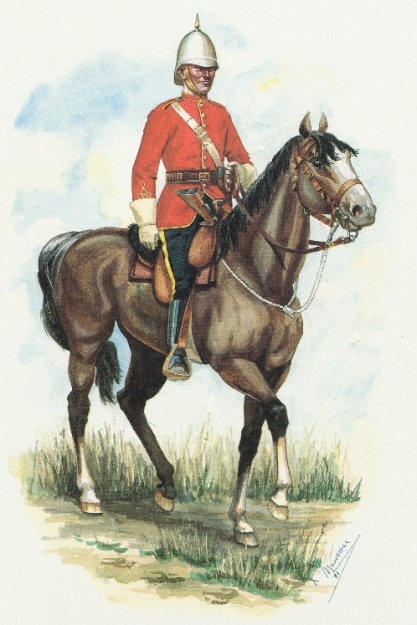
Image - North West Mounted Policeman 1874
For these 1874 Mounties, the terrain turned out to be sparse of grass; little water; little wood; little feed for the livestock and half-rations for themselves. Some of the easterners and their horses drank from contaminated alkali water. This caused men and horse severe sickness and some horses died. Their Metis guides didn't know this country, resulting in poor directions when they left the boundary trail. They encountered lice, mosquitoes, flying ants and grasshoppers. The NWMP mounted on the scruffy western horses from Lower Fort Garry were used to this sort of travel but the easterners that were mounted on their well-bred eastern horses were in poor shape. For 200 miles they followed the Boundary Trail along the American/Canadian border. They then separated into two columns, one going north to Fort Ellice in central Saskatchewan while the main group left the boundary trail to travel into the unchartered territory of what is now south western Saskatchewan The eastern horses that had survived, were skin and bones when they arrived at the "Cripple camp" on the Wood River just north East of present day Lafleche on August 18, 1874. There they were greeted by good water and grass. They decided to halt and set up a camp to rest their men and horses. This became known as the "cripple camp" and the nearby ford of the Wood River as the “cripple crossing". After a period of rest, the stronger men and horses were able to continue the march west to Fort Whoop Up. The rest stayed at the "cripple camp" until they were strong enough to begin their ride back to the east.
Edward Passmore was appointed in 1928 to a Committee of Wood River Old Timers with the task of drawing up a history of the area. Some of this history is quoted in the 1960 booklet “Pioneer Days in Wood River ", as follows:
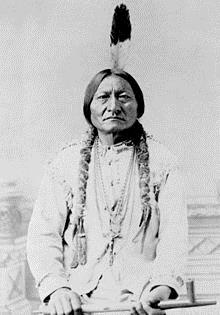
Image - Chief Sitting Bull
In 1876 after the massacre of Custer's 7th Cavalry at the Little Big Horn, Sitting Bull and many of the Sioux Indians, being harassed by a large force of the U. S. Cavalry, crossed over the border and set up camp at Wood Mountain about 23 miles south of Lafleche. The Americans were surprised that only two North West Mounted Police were at the border to control the large band of Indians.
A trading post had been established at Wood Mountain by Jean Louis Legare in 1870. Because of the potentially dangerous situation, the North West Mounted Police established a post at Wood Mountain in order to keep watch on the Sioux and try to induce them to return to the States. Eventually, in 1881, with the help of LeGare, the remnants of the Sioux were induced to return to the States and surrender to the U.S. Cavalry.
When the Railway reached Moose Jaw in 1885, a telegraph line was built down to the North West Mounted Police Post at Wood Mountain. This became known as the " Pole Trail or The Moose Jaw Trail" and became the only landmark for settlers to follow through the treeless prairie in order to reach the Wood River area from the railroad town of Moose Jaw. It passed by east of Old Wives Lake then past the west side of Twelve Mile Lake to Wood Mountain. The trail became the main artery of communication for all those who settled in the area south of Moose Jaw. Because it was used extensively as a freighting trail, stopping places or rest areas were necessary for people, horses and oxen. Some of the place names established on the trail included were Lakeview Hotel, Forty Mile Coulee and Jollys, John Green's Stopping Place. After the expansion of the railroad into this area,the trail was little used and became a conversation piece and memory in the minds of those who used it.
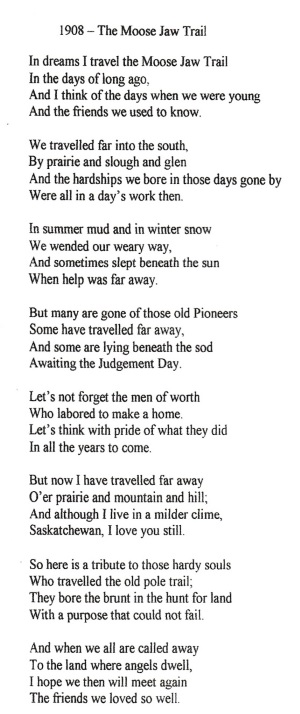
A poem was written by Mr. A MacDonald of Lafleche to honour the Pioneers who traveled the "Pole Trail" from Moose Jaw to the Wood river area. It was read at the funeral of both Edward Passmore and his daughter Laura. Image - To the right, is a copy of this poem
The lands in the Wood River area remained open range until Saskatchewan became a Province in 1905. In 1906 Father Emile Gravel founded a French colony of Roman Catholics just north of the "cripple crossing" at what became known as Gravelbourg.
Within a few years, settlers of all nationalities and religions began arriving in the area. The Wood River area is the land south of Gravelbourg to Wood Mountain, east to 5 Mile Lake and west to Ferland.
Now that you have read the history of the Wood River area, we will go back to the migration of the Passmores from Ontario to Saskatchewan.
Edward and family moved to Port Elgin, Ontario for a short time before they moved to Saskatchewan in 1908.
Several newspaper articles and obituaries show the arrival date of the Passmore families in Saskatchewan as 1906 but documents reveal that the correct date was 1908.
The book "Pioneer Days in Wood River District" mentions that Edward came to Drinkwater Saskatchewan in 1906 and then moved to his homestead in Lafleche in 1908. This conflicts with his obituary and his Golden Wedding newspaper article that indicate that they came west to Drinkwater in 1908 and moved to Lafleche in 1911. The obituary of his brother, George, who died in 1939, also indicates that they came west in 1906 and moved to Lafleche in 1908, as does the family history of Edward's son, Bert. This book indicates that Bert ran a freight service from Lafleche to Moose Jaw from 1908 to 1912. Land documents signed and notarized in November of 1908 establish the actual date of their arrival in Saskatchewan as March of 1908.
While in Saskatchewan in 1907 to reconnoiter for potential homestead sites, Edward's sons, Percy and William Passmore, sent a postcard home to their mother in Ontario reporting on their trip. This card is in my possession and shows the postmark date of 1907. This is further proof that the families did not come west in 1906.
In 1907 the boys scouted the area to be opened for settlement in 1908 and located potentially good homestead sites near the Wood River. They also located land to rent at Drinkwater and Briercrest that included houses and barns. They returned to Ontario by train later that summer. I presume that Edward and George Passmore communicated by mail with the owners of the rental properties and made some sort of commitment to rent the land and buildings when they arrived in 1908.
The conflict in dates regarding the arrival of Edward, George and their families in Saskatchewan, provides further evidence that historians must do everything possible to locate documents that provide evidence that establish the facts. In this case no less than three sources, including a book about the history of the area got the facts wrong.
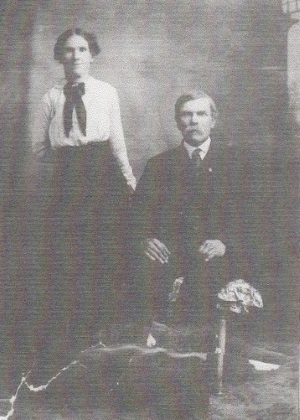
Image - Edward and Catherine’s 25th Anniversary 1908
In the spring of 1908, just in time to celebrate their 25th anniversary, Edward, Catherine and their entire family, along with Edward's older brother George and his family took part in " The Last Great Canadian Land Rush of 1908". Over 1000 square miles of land north of the Wood River had been surveyed in 1905 and 1906 and was being made available to homesteaders. Each successful homesteader would be allocated a quarter section of land. The land would be “proved up" in their name after 3 years if they lived continuously in a shelter on the land and had cultivated at least 3 acres. An additional quarter section adjacent to that land could then be “pre-emptied" if it was applied for at that time.
Thousands of people arrived in Moose Jaw by train and wagon to get into line and apply for homesteads. In 1908 over 14,000 people made land claims and by 1909 the claims had increased by 48%. All of the Passmore family, over 18 years old, got into the line-up at the Canada Land Office near the CPR Station in Moose Jaw. Everybody over the age of 21 filled out their applications and laid down their $10.00. Edward applied for the S.E 1/4 of section 20, Tp. 9, range 5 and applied for the pre-emption of the S. W. 1/4 of section 21. I have a copy of these application forms in the Passmore Journal. The two families then pooled their resources, bought horses and wagons; loaded their possessions in the wagons and set out for the Drinkwater area that the boys had located the previous year. Women and children slept under the wagons or in tents until they reached their destination. On the sworn statement relating to his application Edward indicated that his address was Alhambra, Sask. The women and younger children settled on the rental property at Drinkwater and Briercrest while the elders prepared for the continuation of their trek down to the Wood River area to establish their future homesteads.
Image - Moose Jaw, Canada Land Office 1908

It was necessary to check out their Wood River homesteads early in the spring of 1908 before grass and weeds hid the little surveyor’s stakes. Leaving the women and younger children at Drinkwater, the elders proceeded on to the Wood River area again following the "Pole Trail". Once they reached the area and a surveyor's stake was located, they would tie a ribbon on a wagon wheel, measure the circumference of the wheel, and count the revolutions of the wheel as they traveled. They headed due west of the survey peg until the number of revolutions of the wheel indicated that they were close to a quarter of a mile from the peg. . After the peg was found the same procedure was used to locate all 4 stakes and a suitable location for a "soddy" shanty was selected and marked. They then returned to Drinkwater and Briercrest to plant their crops on the rental property.
Image - Typical covered wagon as used by the Passmore families
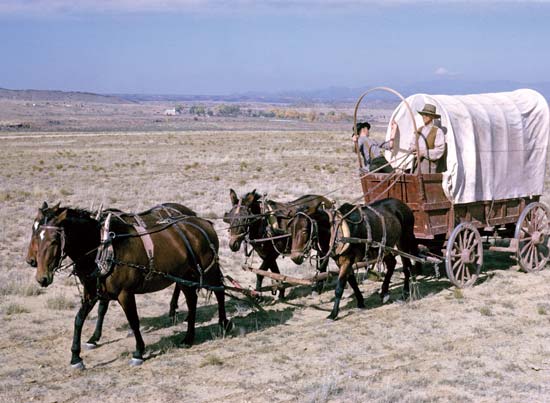
When he was not engaged in actual farming on the rented land at Drinkwater or Briercrest, Edward and some of his family went down to their Wood River homesteads in order to break ground on their homesteads and build shelters. On June 1st of 1908 Edward and his boys built a 10 x 12 Ft. sod shanty and a sod barn 16 x 24 Ft. He then began breaking some of the land. He moved into the shanty on June 30th after he had broken one acre of land. He returned to Drinkwater and brought Catherine back down to show her their homestead. She was repulsed by the thought of living on a dirt floor surrounded by sod walls. When the "Soddie" was first heated, all sorts of bugs and assorted unwelcome visitors would appear out of the sod and invite themselves in for a meal. After experiencing this, Catherine loudly announced that she would return to the rented house at Drinkwater and not return until a "proper house" was built. By December 26 of 1912, Edward had replaced the "soddy" with a 14 x 22 Ft. frame house and added two frame granaries. The old "soddy" was used as a hen house and 45 acres were fenced in.
The newspaper article recording their 50th wedding anniversary does not show that Edward lived on the homestead at Lafleche but, in fact, he did as shown above. He was required to build a shelter, cultivate 3 acres and occupy the land for the majority of the year in order that the land could be "proved up" in his name.
Katherine and the rest of the family left Drinkwater in the spring of 1911 and moved down to the homestead occupying it starting on April 5, 1911. By 1910, 10 acres were cropped, increasing to 40 acres in 1911 and then 90 acres in 1912. The only wood available in the area was at Wood Mountain, almost 23 miles away. The trees were poplar and not suitable for house construction, but fine for firewood. The nearest town on the railway where lumber and building supplies were available was about 80 miles away in Moose Jaw.
Edward's second oldest son, Percy, recognized the opportunity to start a business selling building supplies to settlers. To do this he started to make trips to Moose Jaw to pick up building materials. Each trip on the "Pole Trail" was 3 days each way. He used two wagons in tandem pulled by four horses. As a result, wooden floors and walls were added to the soddies and later all wood buildings began making an appearance on the prairie.
The stories of the hardships faced by these early settlers in their first winter and summer are hard to contemplate. They were faced with the toil of building shelters by hand, breaking the sod with oxen and walking plow for the cultivation of crops and grain. They dug out stones from the plowed furrows and hauled these using "stone boats" pulled by a team of horses to their boundary line. They initially had to haul water also on the stone boats from the Wood River until wells could be drilled. In order to survive the first winter, they were totally dependent on the food that they could grow in the little parcels of land they had cultivated in the first season. The book produced by the Wood River historical committee in 1928, indicates that the first few winters when settlers were trying to become established were extremely harsh.
In the 1906 Census for L.I.D. # 74, which became the Municipality of Wood River, the population was Zero.
On the 1911 census for Lafleche, Edward is 48 with Catherine also 48 and Ernest 14 and Edwin 11 next door to Herbert age 20 who was single and the head of family. The previous family listed on that census is his brother George with Mary and 6 children.
In 1911 the population of the Wood River area was 886. In 1921 it had increased to 2552, made up of 2003 rural dwellers and 356 in the Village of Lafleche and 193 in Woodrow. Lafleche was incorporated as a village until September 3, 1913 just after the CPR Railway reached the town.
On the 1916 Wood River census for Lafleche, Edward is shown as age 54, Catherine 53 with Ernie 19 and Edwin 16. They were at Tp. 9, R. 5, W. 3.
The Land grants of Saskatchewan list the following for Edward Passmore: Part SW Sect 21 Tsp. Range 5, Mer. West and Part SE Sect. 20 and part NW of same section. The date of entry was Jan. 5, 1909 and the date that the Patent was issued was Feb. 12, 1913. This land grant shows that Edward had 17 horses and 8 cows in 1913. Most of the horses were work horses but a few were Morgans, used for both riding and pulling light wagons and sleighs.
Later in the mid 1920’s they moved into his oldest son's house (William) Part NE Sect 18 of same range.
Edward and Katherine were recognized as two of the most highly respected early pioneers of the Sunbeam School District just northwest of Lafleche. Edward's oldest son William held the meeting at his house that formed the Sunbeam School District. When asked to provide a name for the School District, one of the committee looked at the big wood stove in the kitchen that had the name "Sunbeam" on the oven and they agreed to adopt that name.
Most wells were operated by cranking a windless with a bucket tied to it and lifting the full water buckets to the surface. Later on, metal hand pumps were used. First you had to prime the pump with water and then raise and lower the pump handle furiously until the water started flowing into the waiting bucket. Some enterprising farmers utilized windmills to lift water out of deeper wells and into the "dugouts". This water was used for the livestock and irrigation of their vegetable gardens.
Eventually, a tank was installed in the cellar under Grandma's kitchen and water would be pumped up from the outside well into a pipe that filled the tank. Grandma had a small hand pump next to the kitchen sink and pumped up water to the sink from the tank. This was their drinking water. A bucket full of water sat next to the sink from which a dipper hung. When you wanted a drink, you filled the dipper, drank out of it and emptied what was left in it back into the bucket, replacing the dipper onto the edge of the bucket. Not very sanitary but nobody worried about that at the time.
Wash day took all day, usually Monday. Sometimes it would take three days to do one week’s wash when the family were all still at home. All washing was done by hand. After slicing handmade lye soap into a saucepan of water on the stove until it melted into a liquid, Catherine then had to pump enough water into a tub and build a good fire in the stove to heat the water. She then boiled the white things, scrub these on a wash board, then ring them by hand and hang the clothes on the clothesline outside. Light coloured clothes were placed in a tub on the stove and boiled for a short time to loosen the dirt, then picked out of the tub with a wooden spoon and placed in a wash tub and scrubbed by hand, on the ribbed washboard. Many a frustrating hour was spent scrubbing wool socks and long Johns on the scrubbing board before they were taken outside and hung on the line to dry. In the winter time her fingers would become numb and the clothes would instantly freeze solid when hung outside to dry. The frozen clothes would then have to be taken inside to thaw and finish the drying process by standing them up in the corners along the walls behind the stove. The clothes were then hung up on a rack, that hung by pulleys from the ceiling nearby the stove. It was raised and lowered by lines attached to the pulleys. The site of frozen stiff long Johns, with arms and legs sticking straight out, being carried into the house, will always cause me to have a chuckle.
In the spring the weekly clothes washing was a much more pleasant chore but in the heat of summer the hot stove made things very unpleasant in the kitchen. All water had to be heated up on the stove in large pots or cisterns. Later on, reservoirs were fitted onto the wood stoves which supplied a constant source of hot water as long as the stove was on. Heating hot water meant heating up the house which wasn't welcomed in hot summers. Edward built Catherine a screened in porch at the back of the house and installed a small cook stove in it. She called it her summer kitchen and cooked meals and boiled water out there.
Any items requiring ironing would be ironed by a cast metal iron heated up on the wood stove and lifted off the stove with a separate wooden handle. When it cooled, a fresh Iron would be lifted off the stove with the handle and the cold one placed back on the stove for later use. She would sprinkle the clothes for ironing with a bottle of water that had holes punched in the top.
Electric power was not available to most rural areas in Saskatchewan until after World War #2. Everything that we use power tools for had to be done by hand. Light came from kerosene lanterns which had to be pumped up and lit. These gave adequate light for reading. Coal oil lamps gave some light but your eyes got tired if you tried reading for a long time.
In the first few years, the crops were planted in ground where the sod had only just been turned over. This would, hopefully, provide some vegetables and grain for the first winter. For money crops, the ground would be turned over for a year until the sod rotted. The rotted sod would retain moisture and kill the grass and weeds so that the ground could be plowed, harrowed and seeded the next spring. Teams of 4, 6 or even 8 work horses would pull ride on plows with multiple shears or 12 Ft. disk or spring harrows. Two horse teams could only pull single plows or 6 Ft. harrows behind which the farmer walked. This was known as “breaking the land". A 4 horse team would pull a 10 Ft. ride on disk seed drill for planting seed 3 or 4 inches deep. A shallow harrow would be used to control weeds after planting and before the wheat shoots broke the surface. At harvest time, a 4 horse team drawn binder cut the grain, elevated it and bound it into sheaves with binder twine. The sheaves were then stood up by hand against each other into stooks for drying. After a few weeks it was time to bring in the threshing machine. Some huge steam powered tractors arrived on the scene from the U.S.A. during the next few years. These replaced multiple horse teams and provided the power for belt driven threshing machines.
About 1911 Grandpa's sons William and Percy, with some financial backing from Grandpa and his brother George brought in one of the first steam powered tractors and threshing machines in the Wood River area. The threshing machine was a "Belle city". The self-propelled steam engine included a boiler, a fire box and large fly wheels with a power take off. The operator stood on the ground behind it and shoved wood into the fire box. A picture of this is shown below. A few years later a more modern self-propelled steam tractor replaced the old unit.
Image - Treshing outfit
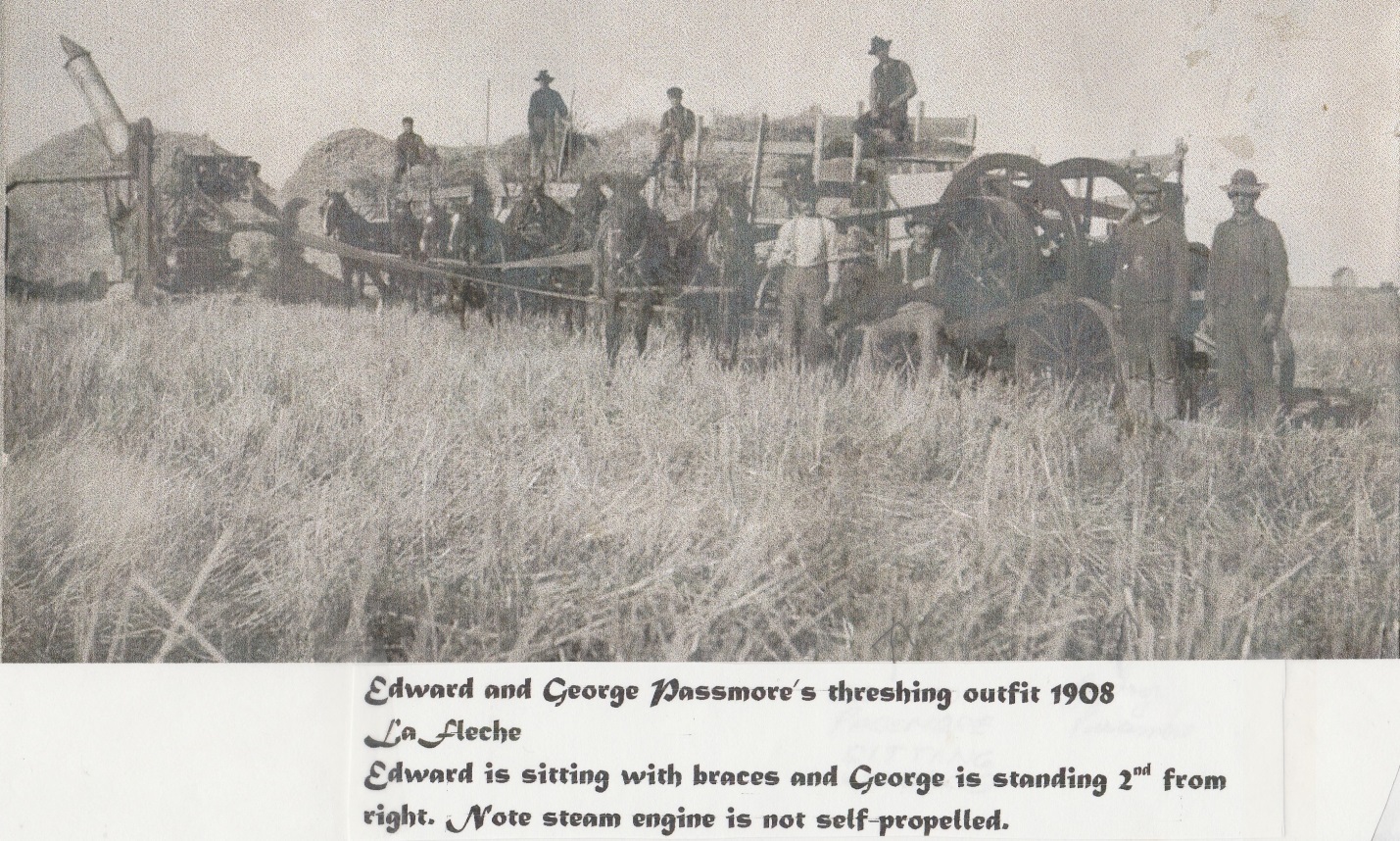
For social activities, friends and relatives would gather at one of the larger houses or at the school house on a Saturday Evening. Festivities would start with a potluck supper. The main meal was at dinner time at noon, so this was not a large meal. Kids would eat in the kitchen and adults wherever they could find a seat. Someone would bring a fiddle and others, perhaps an accordion, guitar or mouth organ. Singing and dancing would commence as soon as dishes were washed. On special occasions, like Halloween, all the kids would dress up. Grandma Katie always received a box of apples from her daughter Laura who had moved to Vernon. The apples arrived just in time for Halloween, There would be apple dunking and if you could bite into one of the immersed apples in the tub, you would get to eat it. Smaller kids would get candied apples. All their grandchildren and friends looked forward to going to Grandma Katie's for Halloween.
There were a great number of relatives around Lafleche. Many came out with the initial rush and others followed along a few years later. The Sunbeam School District Map shows that over a third of the homesteaders in the District were either Passmores, Harrons, Sturgeons, Blacks, Thompsons or some other family that had inter- married with one of these. At Christmas, family units would have dinner with close relatives at home and then get in the sleigh to visit nearby relatives or friends. Easter was generally planting time so most families stayed close to home. By far, most of the social activities took place in the late fall or winter, when there was a lighter work load.
Image - Edward & Catherine descendants
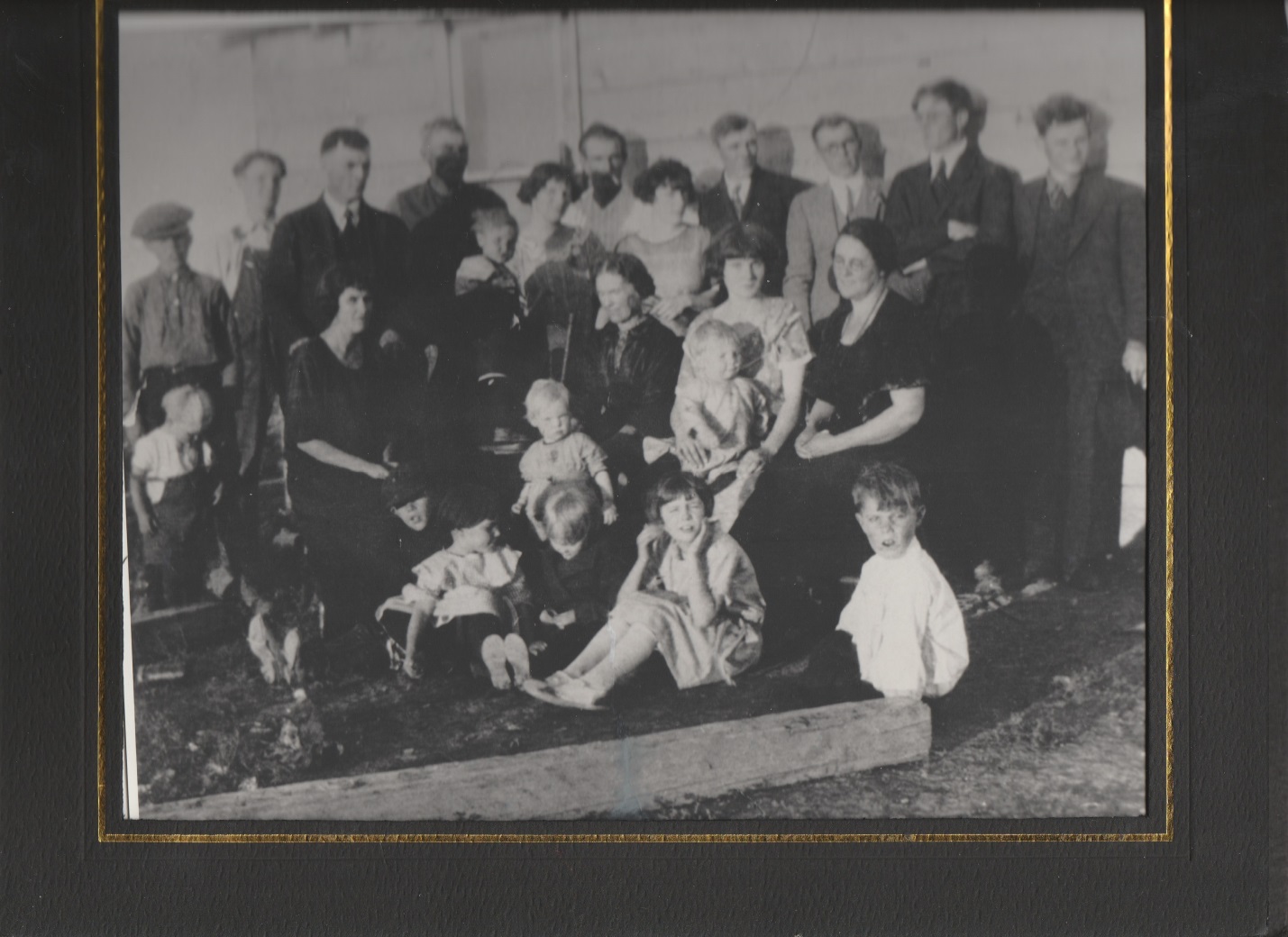
This picture (above) of Edward and Catherine with most of their descendants was taken in the fall of 1924 at Lafleche. Seven Grandchildren are missing including Laura’s three daughters who stayed in Vernon with their father Charles Young, Bert’s son Reginald and three of Percy’s children, Vera, Percy and their baby Lloyd. Seven more grandchildren were born after the picture was taken, including me in 1929.
Image - Hauling wheat to granary

One of the major events of the year and an important social occasion was when the threshing machine arrived. The threshing machine and steam engine or tractor owned by the Passmore family would contract, for so much a bushel, to thresh the wheat of a dozen or so farmers, including all of the Passmores, Harrons, Sturgeons and Blacks as well as other nearby farmers. All of the farmers stayed with the machine and worked for each other as the machine moved from farm to farm. Several men were responsible for throwing the stooks of wheat onto bundle wagons with large hay racks. These were usually driven to the threshing machine by a younger boy who would spread the wheat stocks around the wagon as the stooks were thrown onto it. When it was loaded, another wagon would move into position for loading. At least 8 or as many as 20 bundle wagons would be required to keep the threshing machine busy. The bundle wagons would then be driven to the threshing machine where another crew of two men called "spike pitchers" would throw the sheaves into the feeder of the threshing machine. The owners of the threshing machine would operate the steam powered engine. An unlucky helper had to keep opening the fire box and throwing wood inside. That was a hot job! Large belts ran from the power take-off on the engine to the threshing machine. These would flap and snap and you had to keep well back. The steam engine would huff and puff and every now and again would let off steam with a loud hiss. The operator would blow the whistle for extra sound effects. Other guys tended the machine and moved the chaff spout around which produced a large stack of chaff and straw which would then be hauled to the barn as winter feed for cattle. The grain fell though sieves onto a track where it was elevated into a waiting wagon and hauled to the wooden granaries near the farm house.
When the large elevators in Lafleche had room, or when the price of wheat was right, the wheat would be loaded into wagons and taken to Lafleche. These tall grain elevators were located every 8 or 10 miles along the railway tracks became a unique characteristic of all prairie towns.
Image - Ernie Passmore, my dad, with a threshing crew and steam tractors in 1922
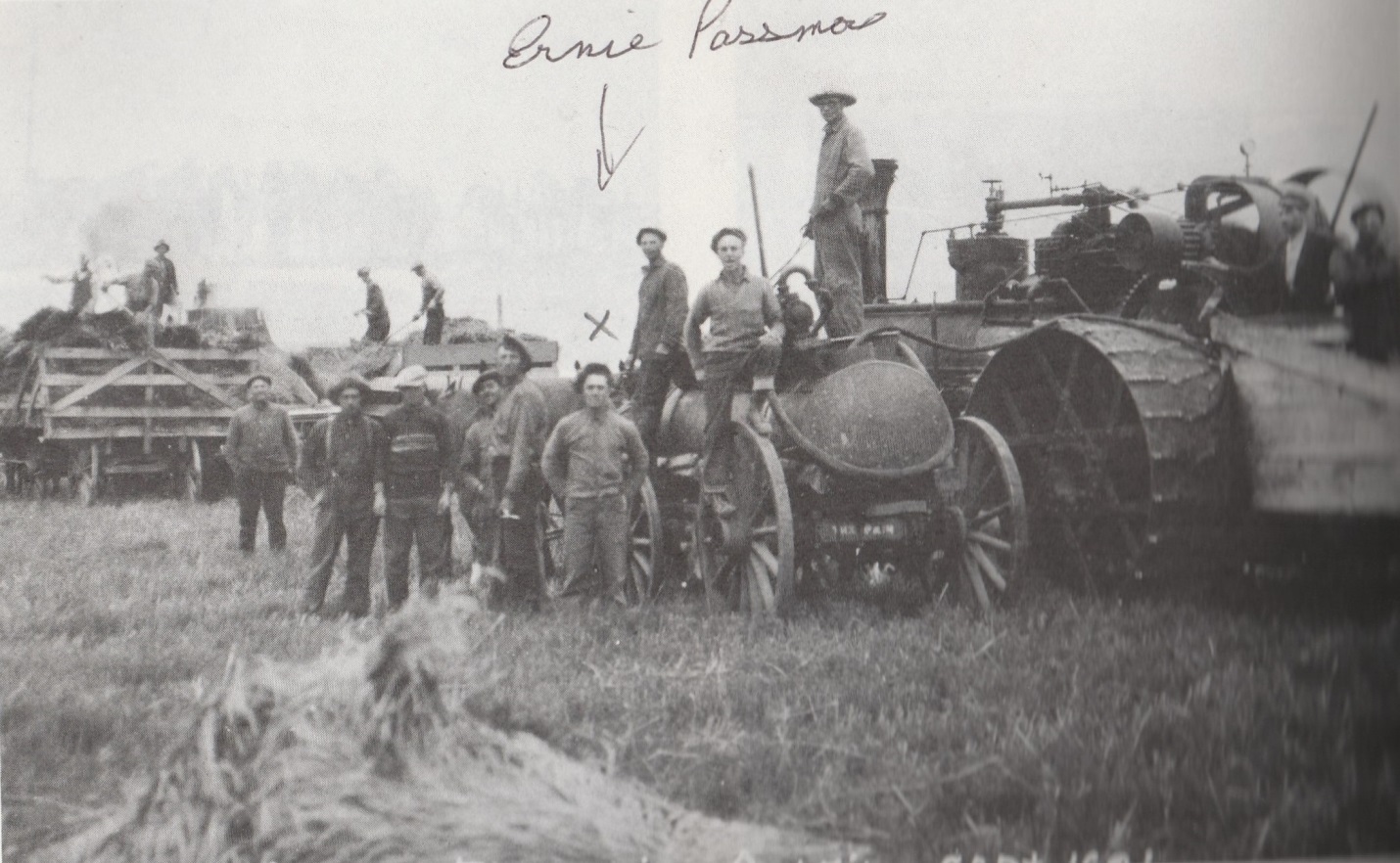
Ernie Passmore, my dad, with a threshing crew and steam tractors in 1922. When Ernie enlisted in the army in1916, he showed his occupation as engineer. Apparently the guy that rode on the steam tractor and put the wood into the fire pit was called an engineer. Dad told me that he could get more power out of a steam engine than anyone else in the area.
It was the responsibility of the women to keep the crew fed. A house in each area would serve as cook house and eating area. The traveling crew had to be billeted and fed. The farmers who lived in the area went home each night for supper and returned in the morning after having breakfast. For the rest of the crew a breakfast of bacon and eggs, potatoes and porridge had to be ready for the crew by 7 AM. Sandwiches would be taken out for the entire crew at 10AM. At dinner time [noon], the entire crew would jump onto wagons and go to the appointed farm house for the main meal of the day. Another meal of sandwiches would be taken out to the crew in the middle of the afternoon.. Water was taken out in flasks or canvas bags for the thirsty crew. If the weather was good they would work from dawn to dusk, which meant that it was necessary to send a fifth meal, of sandwiches, out to the hungry crew about 7 PM. At dusk the traveling crew would again come to the farmhouse for supper. They would sleep wherever they could find a place in the barn, granaries or on the porch. Any accommodation in the farm house was kept for the women who helped with the cooking and cleaning.
All the family assisted each other in the building of houses on their adjacent farms. The first houses were small sod shacks but by the early 1920s larger two story houses were built
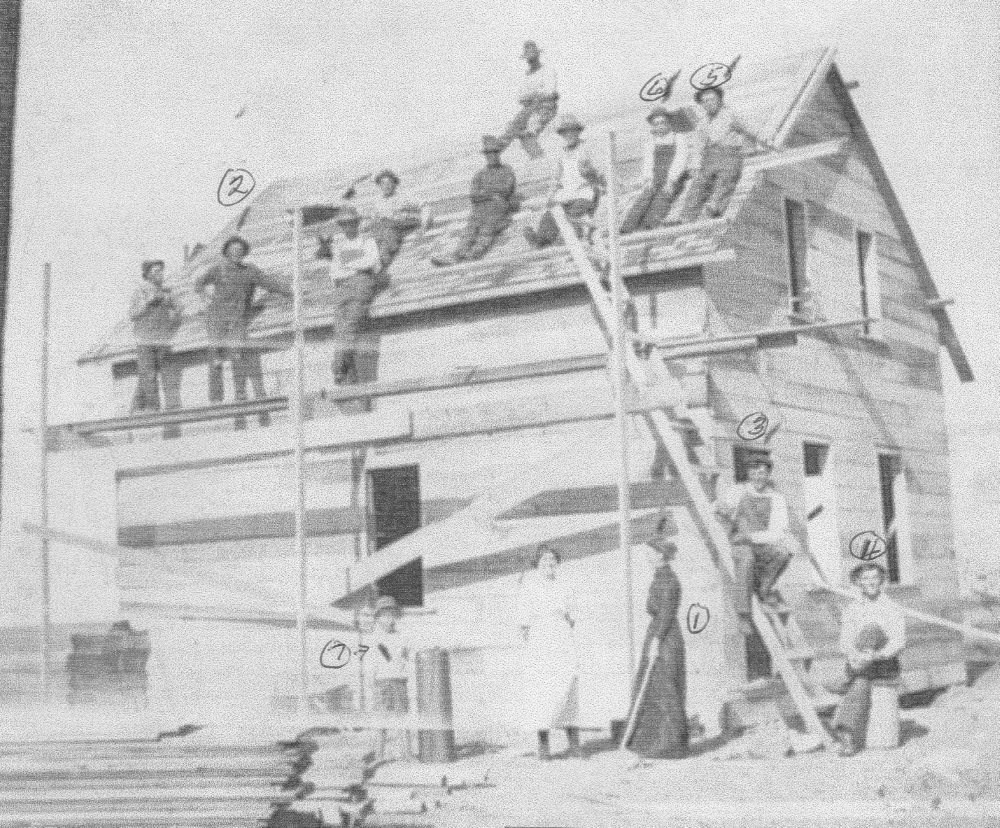
Image - The above picture shows most of the Passmore clan building William’s house in 1914. # 1 is Catherine and #2 is Edward on the scaffold.
Edward took over this house when William moved into Lafleche to open the Globe Theatre in 1927. Everyone in the family would go to the local Christmas Concert. The sleigh box would be placed on the wagon that had been converted to a sleigh and then hitched to team of horses. Rocks were heated and buried in straw on the sleigh to keep the kids feet warm and robes pulled up over their laps so that they would be cozy as they were driven to the schoolhouse for the concert. Sometimes Grandma Katie heated her flat irons on the stove and placed these in blankets on the sleigh to keep the kids warm during the trip. Of course Santa Clause made an appearance and passed out oranges and candies to the kids. When the concert was over the men piled the tables and chairs in the corner for an hour or two of dancing before it was time to pile into the sleigh and head for home. Grandma Katie and her youngest son Edwin played the fiddle for the dancers. The Sunbeam School house had one room and one teacher taught all classes from one to twelve. Two outhouses provided separate facilities for boys and girls. The teacher would help dress the younger kids in the winter for their trek home. I remember that later on in Moose Jaw, my teacher would help with our boots and then wrap a scarf around our heads and over our noses. I had a fur lined cap that would buckle up under my chin and over my ears.
Image - The Passmores were good athletes. Edward on the rear right was the manager of this team, Ernie is kneeling center row 2nd from left, at the front 2nd from left is Eddy and next to him in the middle is William and 2nd from left standing with tie on is Percy, the coach.
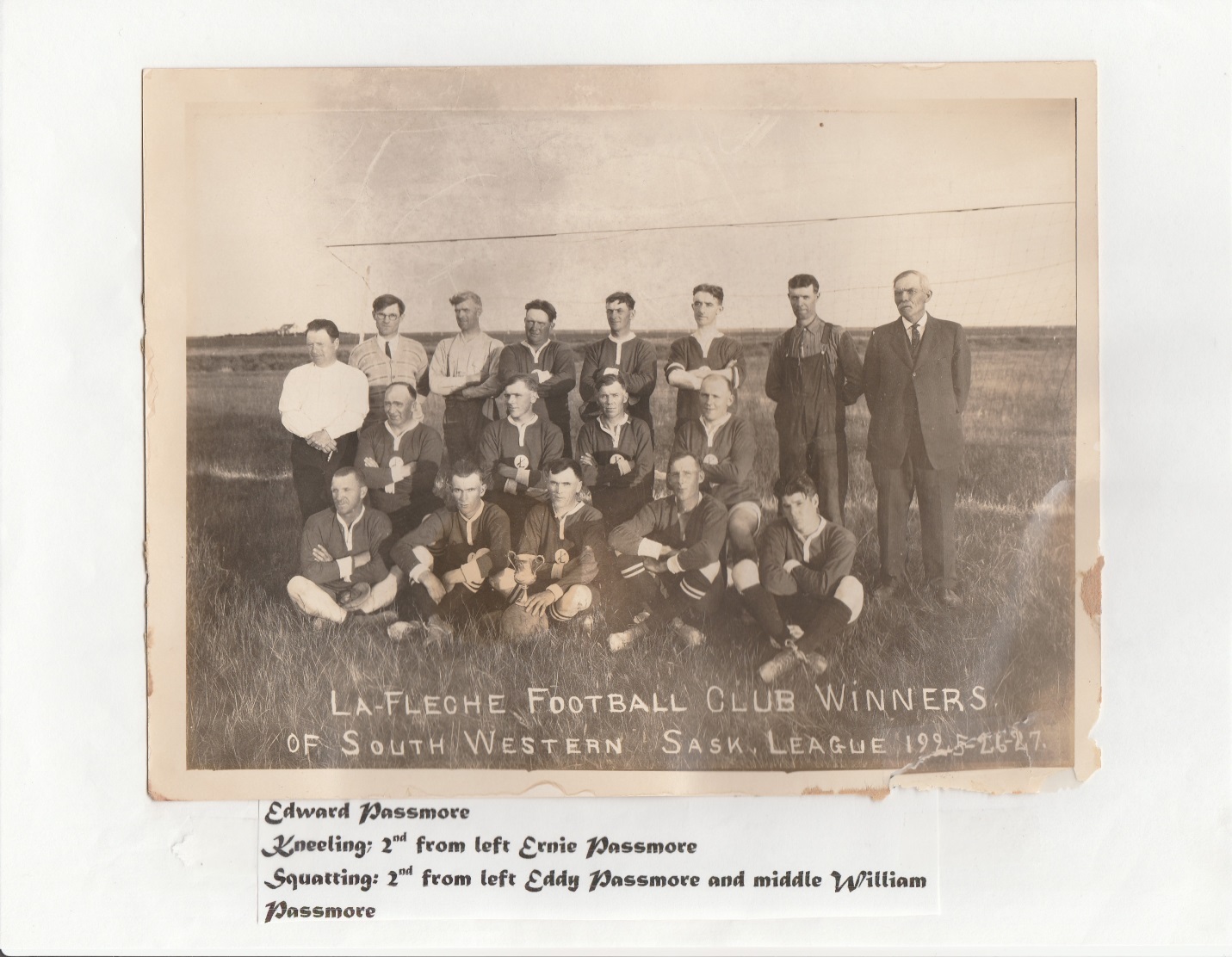
William moved to Moose Jaw in 1931 and opened the Royal Theatre. He was President and Sponsor of the Moose Jaw Royals ladies softball team which won the Canadian. Championship in 1937 and were invited to play at Madison Square Gardens, New York. At that time they were the first foreign team to play there.
William Passmore’s son Bill became the Club Champion and Secretary Manager of the Royal Colwood golf Club in Victoria in 1956 and his son Chuck played NHL Hockey. I managed to win the Victoria Curling Championship in 1953 and 1955 and won the Vernon Senior Men’s wind –up bonspiel a record five times.
Image - 50th Anniversary
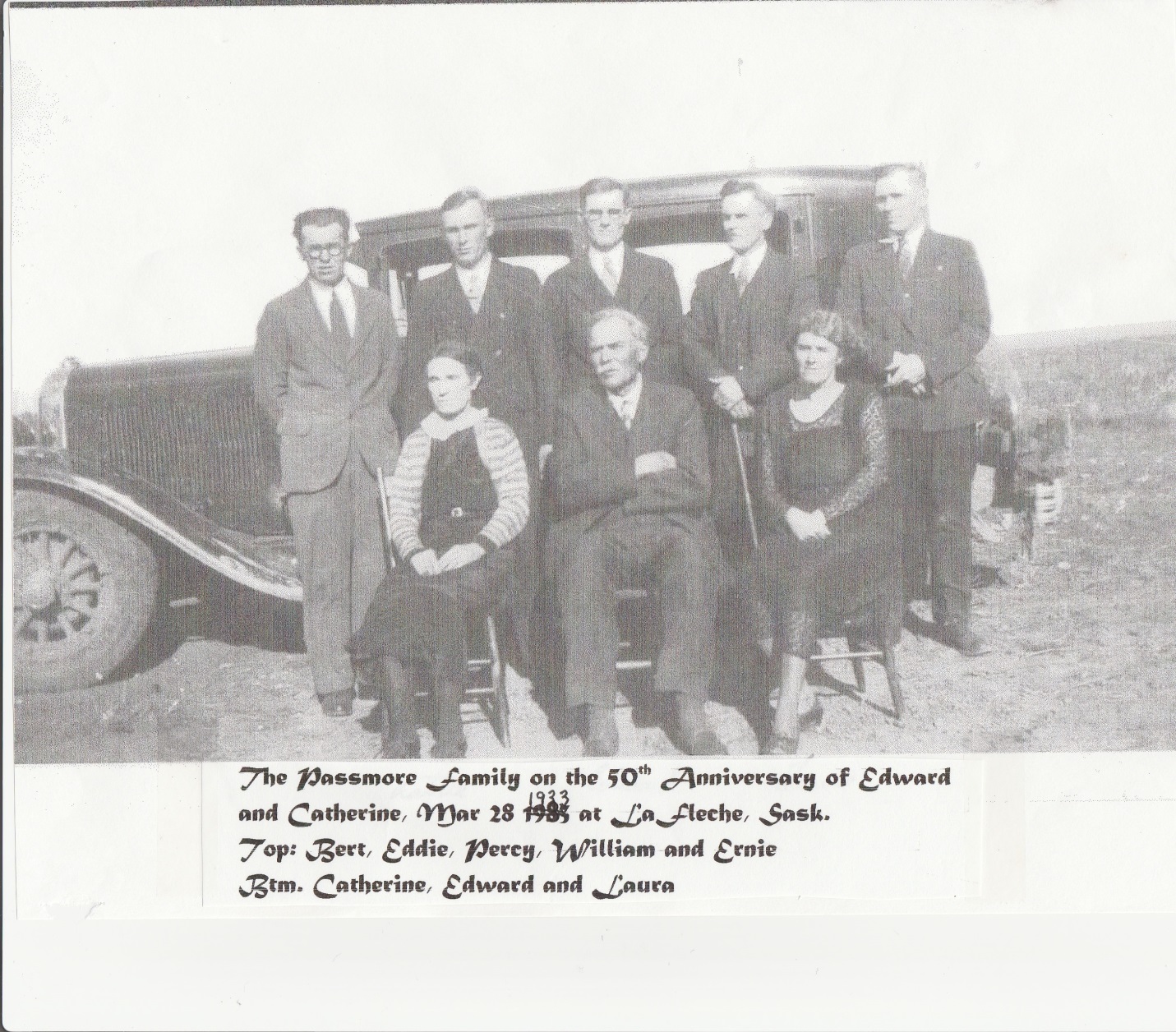
On the occasion of their Fiftieth Anniversary in 1933, about 50 family members and close friends attended. The following was reported in the newspaper article describing the event. To the couples right was their best man at the wedding, Edward's brother George. “Their oldest son William proposed a toast to the couple on behalf of all the children. Ten out of twenty-one grandchildren were present.” Our family from Moose Jaw was represented by Dad and Mom but we children did not attend.
In 1937, our family in Moose Jaw went to visit Grandpa and Grandma in Lafleche and Dad helped with the threshing. I remember going out in the wagon when food and water were taken out to the crew. The crew came back to the farm for supper and my memories include watching a gang of women cleaning up in the kitchen after supper while, out on the porch and in the living room, the men rested. They put their feet up onto anything that was handy and a chorus of snoring echoed around the room. The site of a row of boots at my eye level, topped by a row of open mouths, from which the snores were broadcast, will forever be engraved in my mind.
Image - Edward horsing around with me and my sister Velma and Brother Jack, 1940
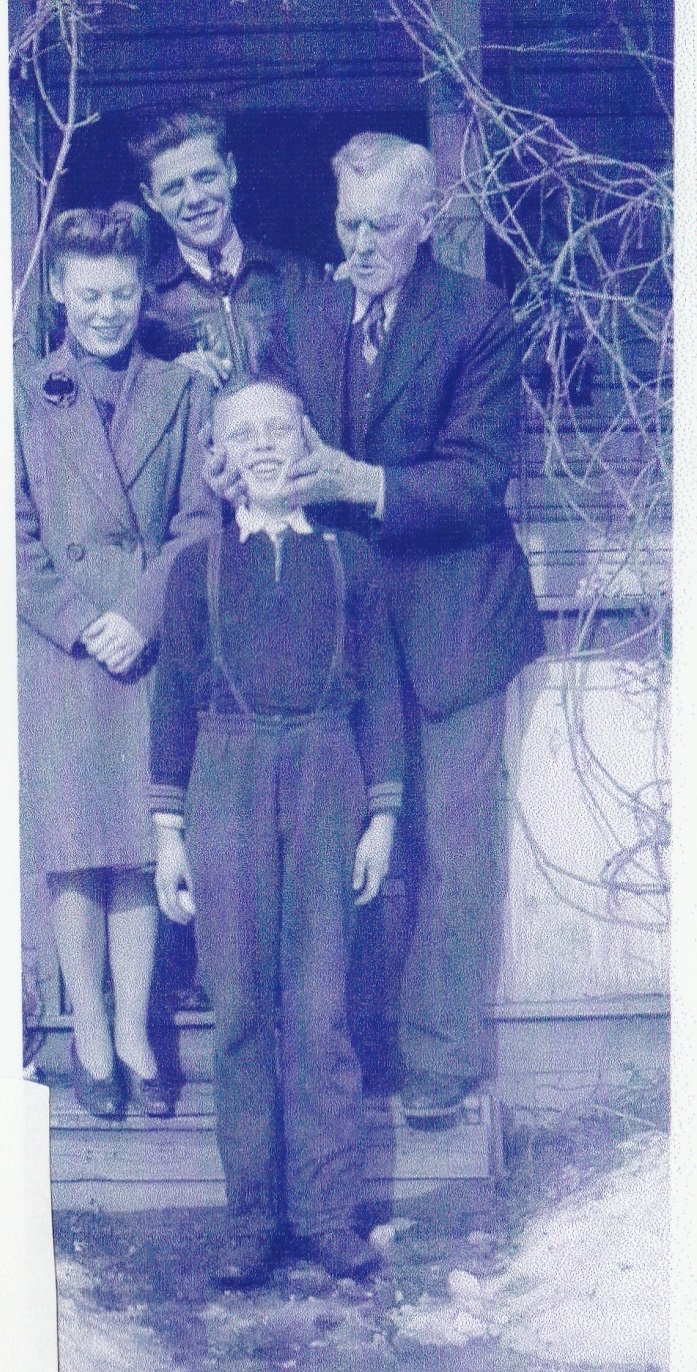
Grandma Katie had chickens and turkeys on the farm as well as pigs, dairy and beef cattle. She also grew some vegetables in her garden. During our visit, when my brother Jack and I came down to breakfast, Grandma had already made porridge and went out to the back porch that she called her summer kitchen to separate some cream for our porridge. The separator had a large cast iron bowl with two spouts and was painted red. When she turned the handle, out came the thick cream from one spout and milk from the other. For two kids from Moose Jaw brought up during the drought and depression of the 30's, this porridge with thick cream and brown sugar was out of this world. She then said “Would you guys like some Ham and eggs?” We of course answered in the affirmative. She cooked up a whole frying pan full of ham and another full of at least eight fresh eggs. All this for two boys aged 7 and 12. She, of course, knew that we were very hard up and on “relief" in Moose Jaw and was making sure that we got our stomachs full while at Grandma's house. I had never tasted either porridge with pure thick cream or ham and eggs in my life. Our standard breakfast in Moose Jaw was either bread and milk or porridge but never with cream. Sometimes, when milk wasn't available, Mom served us bread and hot water with brown sugar. Those remain as my profound memories of my Grandma Katie.
For that visit, we were taken from Moose Jaw to Lafleche by our neighbour, Charlie Baker, in his car. He was relatively well off as he worked for the CPR. I remember the car sliding around on the gravel road when he ran into a herd of “army worms" which were crossing the road. These things ate everything that was in the path of their march. I believe that 1937 was one of the bad years for grasshoppers. The sun shone all the time and the temperature was in the 90's most of the time. Great swarms would virtually block out the sun and clean out a farmer’s field in a matter of hours. When you walked in the field they would fly up in front of you and make such a crackling noise with their wings that it blocked out all other sounds. Grandpa said that they would even eat the fence posts. (Perhaps this was an exaggeration but it is a good description of the damage they would inflict).
What little snow that came during these drought years was shoveled up around the base of the houses to provide some insulation from the cold. Temperatures down to minus 45 F. we’re not uncommon. There was no insulation in the houses and no central heating. The cook stove in the kitchen and a pot-bellied heater in the living room provided all the heat. Walls were frequently papered with old newspapers or magazines. There were no bathrooms in the houses so an outhouse had to be used. Toilet paper was a luxury, so newspapers, magazines or catalogs were the usual wipers. In the winter time at night a chamber pot was used.
If there was enough snow, it would be scooped up into a tub and melted on the kitchen stove for soft water. The smell of snow melting on top of the stove is another of my memories of the prairie winters. One summer when we were at Grandpa's house for a visit, a large black cloud appeared in the southeast. It was a prairie dust storm. All the kids were hustled into the root cellar (or hen house) along with whatever chickens could be caught. The tin covered sloping heavy door over the entrance stairs was closed and a coal oil lamp lit. The adults and babies went down into the cellar under the house and the animals were herded into the barn and all doors were closed. We were all scared but the storm passed nearby and didn't do any damage to Grandpa's farm except deposit dirt and dust everywhere. When we came out of the root cellar, it was still dark but the danger had passed. Dust storms were frequent which lifted top soil into the air and carried it for miles.
Grandpa had three wagons. A large wagon which could be fitted with racks for hay, a democrat with two rows of seats and a rear rack for hauling goods back from town and a wheat wagon with high sides and a removable rear door that was lifted up to let the wheat run out when he took it to the elevator. These were pulled by a two horse team. He also had a cutter which he used in the winter time. I have the neck yoke from this cutter that I found under his collapsed barn in 1976. I also remember his wheat auger that was used to lift wheat up from his granaries into his wheat wagon. It stood at the side of the barn and their hens would roost on it at various levels up to the top about 12 Ft. high. Eggs were hard to retrieve up there.
The following children of Edward and Katherine were married in Saskatchewan: William and Laura were married in Briercrest and Drinkwater in 1908 before the families moved to Lafleche. Bert and Percy were married in 1911 and 1914 in the Lafleche area. My dad Ernie and Edwin were married in Vernon after they made a trip out to visit their sister Laura. They met their future wives in Vernon on that trip.
Image - Edward Passmore 1861- 1944

My family moved from the farm to the village of Lafleche about 1926 at about the same time that Uncle Willie moved into town and opened up the Globe Theater in Lafleche. Edward moved into Willie's house across the road and this is the house that I referred to in above memories. Edward and Katie lived there until their deaths.
Edward visited our family in Vernon a couple of times in 1940 and his last visit was to attend my sister Velma's wedding in April of 1944.
I remember Grandpa as a tall easy going “grandfather" type with a bit of a drawl in his voice. He was about 6 Ft. tall and had a bushy mustache and a big booming laugh. He liked to tease and was always willing to spend time with his grandchildren. I always looked forward to his visits. He liked to twist his mustache when he told a story. He always carried a jackknife and liked to sit and whittle while he talked. He taught me to play knives, a game where you put the point of a knife to your finger then flip it so it sticks into the ground. You move it to all your fingers and thumb, then up to your elbow, shoulder and then up to your nose. If the blade sticks in the ground every time you would then witch to the other hand. If the knife doesn't stick up in the ground, you give it to your opponent who tries to go further than you. Grandpa was very good at this game of "knives".
He told me some colourful tall stories. He said that sometimes it was so cold that it froze your words when they came out of your mouth so you had to avoid swearing because people could read what he said! Another time, he said that the mosquitoes were so big that, while working on top of his hay wagon, he was lifted up off the wagon by a hoard of mosquitoes!
When his youngest son Eddy opened up a barbershop and billiard parlour (pool hall) in Vernon in the early thirties, Grandpa was shown as a part owner. He must have provided some of the capital for the enterprise. My dad became the official bouncer and set up man in the pool hall in 1938 when we moved to Vernon.
Catherine died in 1941 and is buried at the Lafleche Cemetery.
Edward died November 16 1944 at Moose Jaw. He is buried at the Lafleche Cemetery. His Death Certificate shows his date of birth as Oct 18, 1860 but the 1901 census for Glammis, Bruce County, Ontario shows his date of birth as Oct 18, 1861. His age on his Marriage Registration dated March 28, 1883 is 21 which agree with the 1901 census. The Registration of Births at St John's Anglican Church, Bervie, Ontario confirms that his date of birth is Oct 18, 1861.
When he died in 1944, his other sons each sent money to his son, Bert, in Lafleche to erect a head stone on his grave. This was never done! In 2004, Kevin Passmore, (Bert’s grandson) finally had one erected. Bert was not respected (to say the least) by his brothers and their families because of this and several other questionable transactions that he conducted.
A mild family feud developed between the descendants of N. H. Bert Passmore and his siblings over how he obtained most of the family's farms. This has largely been forgotten after most of the family moved away from Lafleche. The family was decidedly split for many years. In 1976, I attended the funeral of Bert's wife Ethyl in Lafleche and the two parts of the family stood on opposite ends of the graveyard not talking to each other. I moved back and forth between the two groups trying, unsuccessfully, to get the factions together. At that time grandpa's grave was unmarked. Since them I believe that time is a great healer and the bridges have been mended.
Edward and Catherine Passmore leave behind many descendants all over Canada and the USA. Some were able to sell their farms at a time when the market was good and move away to better things. However, those that hung on until the Great Depression did not fare as well.
Laura and Charlie moved to Vernon and acquired quite a lot of real estate. When the Vernon Civic Center was built in the 1960's, they owned at least four houses on the site.
William invested in movie theatres in Lafleche, Moose Jaw and Esquimalt. He also owned a large apartment building in Victoria.
Percy and Ethel moved to Moose Jaw where he became a department head in a large department store.
Bert and Ethyl ended up with most of the family's farm near Lafleche.
George Ernest, my dad, was a decorated hero in World War #1 and served in England in World War #2.
Edwin and Dolly sold the farm and bought a pool hall and barber shop in Saskatchewan before moving to Vernon and obtaining the Brunswick Billiard Parlor and Barber Shop there. They moved to Vancouver where they owned the Airway Auto Court in North Vancouver.
Most of Edward's Grandchildren owned or managed successful businesses on the Prairies or in British Columbia. Eight of these served overseas in World War #2.
This is quite a tribute to a man who never completed his high school education.